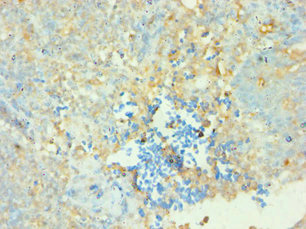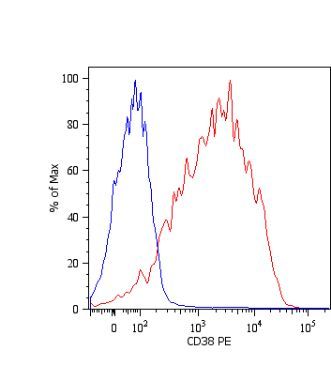![FACS analysis of human peripheral blood using GTX22577-14 CD38 antibody [HIT2] (PE-DyLight 594). Antibody amount : 4 microl reagent / 100 microl of peripheral whole blood FACS analysis of human peripheral blood using GTX22577-14 CD38 antibody [HIT2] (PE-DyLight 594). Antibody amount : 4 microl reagent / 100 microl of peripheral whole blood](https://www.genetex.com/upload/website/prouct_img/normal/GTX22577-14/GTX22577-14_20191025_AP_006_173_w_23060620_358.webp)
FACS analysis of human peripheral blood using GTX22577-14 CD38 antibody [HIT2] (PE-DyLight 594). Antibody amount : 4 microl reagent / 100 microl of peripheral whole blood
CD38 antibody [HIT2] (PE-DyLight 594)
GTX22577-14
ApplicationsFlow Cytometry
Product group Antibodies
TargetCD38
Overview
- SupplierGeneTex
- Product NameCD38 antibody [HIT2] (PE-DyLight 594)
- Delivery Days Customer9
- Application Supplier NoteFACS: 4 microl reagent / 100 microl of whole blood or 106 cells in a suspension. *Optimal dilutions/concentrations should be determined by the researcher.Not tested in other applications.
- ApplicationsFlow Cytometry
- CertificationResearch Use Only
- ClonalityMonoclonal
- Clone IDHIT2
- ConjugateDouble Conjugated
- Gene ID952
- Target nameCD38
- Target descriptionCD38 molecule
- Target synonymsADPRC 1, ADPRC1, cADPR1, ADP-ribosyl cyclase/cyclic ADP-ribose hydrolase 1, 2'-phospho-ADP-ribosyl cyclase, 2'-phospho-cyclic-ADP-ribose transferase, ADP-ribosyl cyclase 1, CD38 antigen (p45), NAD(+) nucleosidase, cluster of differentiation 38, cyclic ADP-ribose hydrolase 1, ecto-nicotinamide adenine dinucleotide glycohydrolase
- HostMouse
- IsotypeIgG1
- Protein IDP28907
- Protein NameADP-ribosyl cyclase/cyclic ADP-ribose hydrolase 1
- Scientific DescriptionThe protein encoded by this gene is a non-lineage-restricted, type II transmembrane glycoprotein that synthesizes and hydrolyzes cyclic adenosine 5-diphosphate-ribose, an intracellular calcium ion mobilizing messenger. The release of soluble protein and the ability of membrane-bound protein to become internalized indicate both extracellular and intracellular functions for the protein. This protein has an N-terminal cytoplasmic tail, a single membrane-spanning domain, and a C-terminal extracellular region with four N-glycosylation sites. Crystal structure analysis demonstrates that the functional molecule is a dimer, with the central portion containing the catalytic site. It is used as a prognostic marker for patients with chronic lymphocytic leukemia. Alternative splicing results in multiple transcript variants. [provided by RefSeq, Sep 2015]
- Storage Instruction2°C to 8°C
- UNSPSC12352203

![FACS analysis of human CD38 positive monocytes (red-filled) and human CD38 negative lymphocytes (black-dashed) using GTX22577-14 CD38 antibody [HIT2] (PE-DyLight 594). Antibody amount : 4 microl reagent / 100 microl of peripheral whole blood FACS analysis of human CD38 positive monocytes (red-filled) and human CD38 negative lymphocytes (black-dashed) using GTX22577-14 CD38 antibody [HIT2] (PE-DyLight 594). Antibody amount : 4 microl reagent / 100 microl of peripheral whole blood](https://www.genetex.com/upload/website/prouct_img/normal/GTX22577-14/GTX22577-14_20191025_AP_006_174_w_23060620_523.webp)


![IHC-P analysis of chronically inflamed human bronchus tissue using GTX01959 CD38 antibody [SPC32]. Note intense membrane staining of infiltrating activated T lymphocytes.](https://www.genetex.com/upload/website/prouct_img/normal/GTX01959/GTX01959_20200811_IHC-P_20_w_23053121_469.webp)